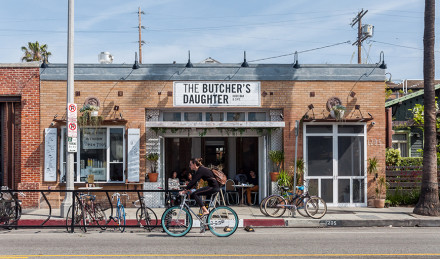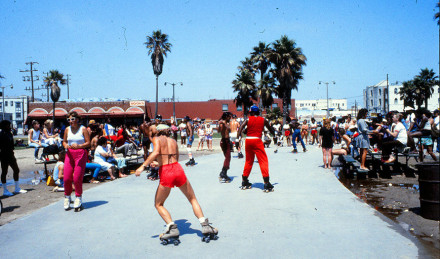When we say “Venice,” you think beach, boardwalk, bikes, bungalows – not to mention great shopping for your home (ahem). But Venice has also been a failed utopia, a slum, an artist’s enclave, a hippie hangout and the epicenter of skate culture. It’s been a wild ride, to say the least. This bohemian corner of West L.A. is the inspiration for our signature Venice set and the neighborhood we call home. So we thought we’d give you a little insight into the past of this eccentric community perched on the Pacific.
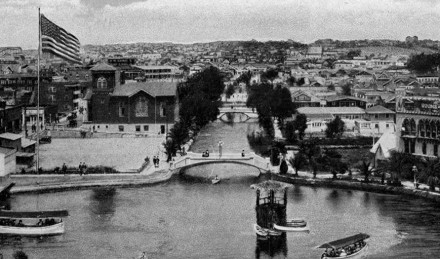
Neither its visionary founder nor the finest boardwalk fortune teller could have predicted Venice’s future when the city welcomed its first visitors in 1905. Abbot Kinney set out to build a resort destination that was more than just a getaway, but a worldly center for a Renaissance by the sea. The east coast developer imagined a high-brow cultural hub with a 3,500 seat auditorium — the Venice Assembly — as its centerpiece and a picturesque residential district connected by a series of canals, just like its Italian namesake. Kinney’s grand plan opened to the public with much fanfare, but he quickly found visitors were far more interested in the amusements on the pier than the lineup at the Assembly. Business sense trumping his cultural ambitions, Kinney focused capital on the roller coasters, miniature railroad rides and high-flying aerial shows that kept the boardwalk full and established Venice as the “Coney Island of California.”
Neither its visionary founder nor the finest boardwalk fortune teller could have predicted Venice’s future when the city welcomed its first visitors in 1905. Abbot Kinney set out to build a resort destination that was more than just a getaway, but a worldly center for a Renaissance by the sea. The east coast developer imagined a high-brow cultural hub with a 3,500 seat auditorium — the Venice Assembly — as its centerpiece and a picturesque residential district connected by a series of canals, just like its Italian namesake. Kinney’s grand plan opened to the public with much fanfare, but he quickly found visitors were far more interested in the amusements on the pier than the lineup at the Assembly. Business sense trumping his cultural ambitions, Kinney focused capital on the roller coasters, miniature railroad rides and high-flying aerial shows that kept the boardwalk full and established Venice as the “Coney Island of California.”
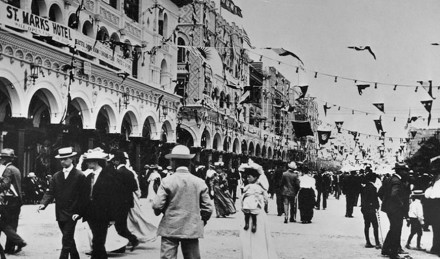
A disastrous fire and clashes over leadership and development – plus the onset of the Great Depression – ushered in an era of decline for the beach community. According to Southland, “By the 1920s, the canals had become seen as an obstacle to progress. Poor circulation meant that the water was often polluted. More importantly, many visitors were now arriving by automobile, but Venice offered scarce parking, and its streets were designed for pedestrians, not motorcars.”
In 1929, after a three-year court battle with the city of Los Angeles, many of Venice’s iconic canals were paved over. The dance halls and casinos on the promenade – once major money-makers – had gained reputations for attracting unsavory characters, and the ornate Venetian-style facades that lined commercial blocks fell into a state of disrepair. But the grit of the seaside community held certain allure for artistic and rebellious spirits. Charles and Ray Eames opened their office on Abbot Kinney Boulevard in 1943, establishing a creative laboratory for modern design that thrived on experimentation and collaboration — and produced some of the most iconic pieces of furniture in the 20th century.
A disastrous fire and clashes over leadership and development – plus the onset of the Great Depression – ushered in an era of decline for the beach community. According to Southland, “By the 1920s, the canals had become seen as an obstacle to progress. Poor circulation meant that the water was often polluted. More importantly, many visitors were now arriving by automobile, but Venice offered scarce parking, and its streets were designed for pedestrians, not motorcars.”
In 1929, after a three-year court battle with the city of Los Angeles, many of Venice’s iconic canals were paved over. The dance halls and casinos on the promenade – once major money-makers – had gained reputations for attracting unsavory characters, and the ornate Venetian-style facades that lined commercial blocks fell into a state of disrepair. But the grit of the seaside community held certain allure for artistic and rebellious spirits. Charles and Ray Eames opened their office on Abbot Kinney Boulevard in 1943, establishing a creative laboratory for modern design that thrived on experimentation and collaboration — and produced some of the most iconic pieces of furniture in the 20th century.
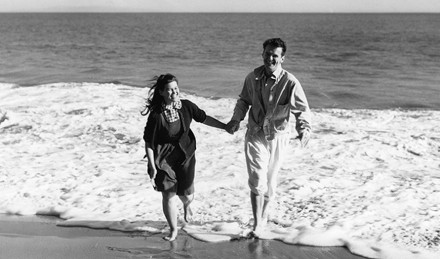
As the community’s carnival past continued to fade, California’s counterculture also took root. Drawn by cheap rents and beachy vibes, artists and writers recolonized the down-and-out resort into a hippie mecca with a “live and let live” ethos. Beat poets set up an Ocean Front hangout called the Gas House for readings, jazz shows and conceptual art experiences. A pair of UCLA graduates named Jim and Ray got together on the beach to form a little band called The Doors. Performance artist Chris Burden could have shocked even the toughest sword swallowers from the boardwalk’s past when he staged his most notorious piece, Trans-Fixed, on Speedway Avenue.
As the community’s carnival past continued to fade, California’s counterculture also took root. Drawn by cheap rents and beachy vibes, artists and writers recolonized the down-and-out resort into a hippie mecca with a “live and let live” ethos. Beat poets set up an Ocean Front hangout called the Gas House for readings, jazz shows and conceptual art experiences. A pair of UCLA graduates named Jim and Ray got together on the beach to form a little band called The Doors. Performance artist Chris Burden could have shocked even the toughest sword swallowers from the boardwalk’s past when he staged his most notorious piece, Trans-Fixed, on Speedway Avenue.
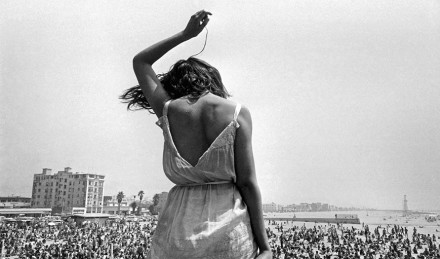
While bikes have always been a staple of Venice, the ’70s ushered in a new kind of transportation — and subculture that would define the neighborhood. The Zephyr skateboard team found their footing on secret spots off the roller coaster ruins of Pacific Coast Park Pier before getting their land legs. They dubbed their territory Dogtown, cruising the streets of Santa Monica and Venice in search of steep hills and empty pools to “go big.” Not only did the Z-Boys invent modern, competitive skateboarding, but they also sparked a youth culture movement that influenced style, music and pop culture to this day. Skating was cool, carefree, unconventional and yes – a little bit dangerous. It was very Venice.
While bikes have always been a staple of Venice, the ’70s ushered in a new kind of transportation — and subculture that would define the neighborhood. The Zephyr skateboard team found their footing on secret spots off the roller coaster ruins of Pacific Coast Park Pier before getting their land legs. They dubbed their territory Dogtown, cruising the streets of Santa Monica and Venice in search of steep hills and empty pools to “go big.” Not only did the Z-Boys invent modern, competitive skateboarding, but they also sparked a youth culture movement that influenced style, music and pop culture to this day. Skating was cool, carefree, unconventional and yes – a little bit dangerous. It was very Venice.
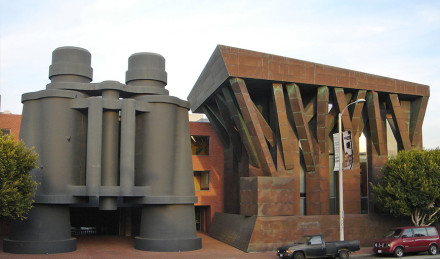
The canals finally got a full facelift in the ’90s, and the improved curbside appeal attracted an influx of independent businesses and creative entrepreneurs. Today, Google maintains an office a few blocks from the beach (in a Frank Gehry-designed building, no less), Vice and Snap have taken over entire stretches of Venice Boulevard, and Abbot Kinney has been called “the Coolest Block in America.” But make no mistake, Venice is as proudly unpredictable as ever. It’s still a place where you can spend a day watching skaters and street performers; A place where it’s just as easy to buy bespoke bicycles as it is to buy a cheesy seaside souvenir; A place where you can get your palm read and then eat some of the best pizza on the West Coast. In Venice, only one thing’s for certain: The weather will be wonderful.
The canals finally got a full facelift in the ’90s, and the improved curbside appeal attracted an influx of independent businesses and creative entrepreneurs. Today, Google maintains an office a few blocks from the beach (in a Frank Gehry-designed building, no less), Vice and Snap have taken over entire stretches of Venice Boulevard, and Abbot Kinney has been called “the Coolest Block in America.” But make no mistake, Venice is as proudly unpredictable as ever. It’s still a place where you can spend a day watching skaters and street performers; A place where it’s just as easy to buy bespoke bicycles as it is to buy a cheesy seaside souvenir; A place where you can get your palm read and then eat some of the best pizza on the West Coast. In Venice, only one thing’s for certain: The weather will be wonderful.
